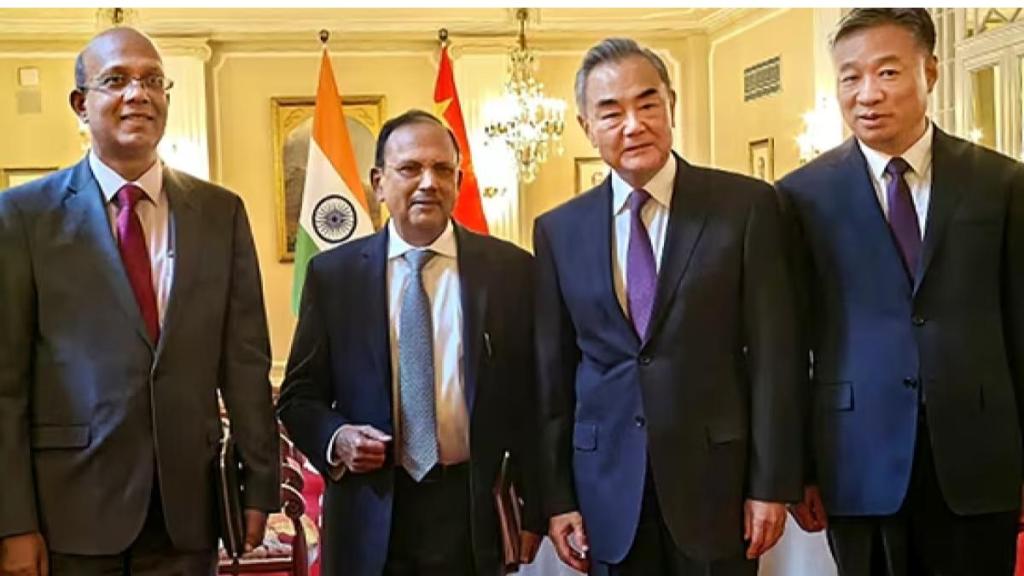After a gap of five years, National Security Advisor (NSA) Ajit Doval has arrived in Beijing for pivotal talks with Chinese Foreign Minister Wang Yi. The discussions mark a significant step in the ongoing efforts to stabilize and strengthen the diplomatic and strategic relationship between India and China, particularly regarding their longstanding border dispute.
The meeting between Doval and Wang Yi is part of the Special Representatives (SR) talks mechanism, which was established in 2003 to address the complex border issue between the two countries. This round of talks comes at a critical juncture, following a period of heightened tensions due to the 2020 military standoff in eastern Ladakh and the Galwan Valley clash. These talks are not only important because of the historical context but also because they occur after significant agreements were reached in recent months, most notably a disengagement pact signed in October 2023.
The Importance of the Special Representative Talks
The SR talks between India and China are crucial for a variety of reasons. Primarily, they focus on the management of peace and tranquillity along the Line of Actual Control (LAC), which is the de facto border between the two countries. The LAC has been a source of friction for decades, and the 2020 face-off in eastern Ladakh escalated tensions to an unprecedented level, resulting in a deadly clash that claimed the lives of several soldiers from both sides.
Since then, there have been multiple rounds of military and diplomatic negotiations, but the SR talks offer a unique platform for high-level discussions between senior officials from both governments. These talks have historically been instrumental in defusing tensions and laying the groundwork for potential long-term solutions. However, despite the number of rounds—22 in total—over the years, a permanent resolution to the border issue has remained elusive.
The significance of these talks is further heightened by the broader geopolitical context. Relations between India and China, two of the world’s most populous and powerful nations, impact not only regional stability but also global security and economic dynamics. The two countries share a border that spans 3,488 kilometers, and their relationship has implications for neighbouring countries, the broader Indo-Pacific region, and global supply chains.
Agenda of the Talks: Border Disputes and Mutual Trust
At the heart of the 23rd round of SR talks is the need to restore the trust and stability that had been severely damaged by the 2020 standoff. The agenda, as outlined by the Ministry of External Affairs in New Delhi, includes a focus on managing peace and tranquillity in the border areas and exploring fair, reasonable, and mutually acceptable solutions to the boundary dispute.
China expressed optimism ahead of the talks, with Foreign Ministry spokesperson Lin Jian emphasizing that Beijing is “ready to work with India” to implement the common understandings reached between Prime Minister Narendra Modi and Chinese President Xi Jinping during their meeting in Kazan, Russia, in October. This meeting was the first direct bilateral conversation between the leaders after five years and is seen as a positive step toward de-escalating tensions. Lin Jian further emphasized China’s readiness to “respect each other’s core interests,” strengthen mutual trust, and resolve differences with sincerity and good faith.
The recent disengagement agreement, which was finalized on October 21, 2023, is a key component of the talks. This agreement marked the completion of a step-by-step disengagement process along the LAC, with the last two friction points—Demchok and Depsang—finally seeing military pullbacks. The SR talks are expected to review the implementation of this agreement and discuss further measures to ensure that the disengagement process remains stable, preventing future flare-ups.
The Role of the Special Representatives Mechanism
The SR talks mechanism has been an essential tool for addressing the complex and sensitive issues between India and China. Over the years, it has helped defuse several crises, even though it has not been able to resolve the boundary dispute definitively. The SR talks serve as a high-level diplomatic channel where both sides can engage in candid discussions about their core concerns, especially with regard to the LAC and broader security issues.
In the aftermath of the Galwan Valley clash in June 2020, this mechanism became even more significant, as both countries sought a way to manage their military standoff without escalating into a full-blown conflict. The SR mechanism has offered a structured platform for dialogue, allowing India and China to manage their differences without resorting to military confrontation.
While the boundary dispute remains unresolved, both India and China view the SR talks as a valuable tool for managing tensions. The ongoing engagement is seen as vital in maintaining peace along the border, and there is hope that the dialogue will eventually lead to a lasting resolution.
The Broader Implications for India-China Relations
The SR talks are not just about resolving the border dispute—they are part of a larger effort to rebuild and stabilize India-China relations. Following the Galwan clash, trade between the two nations has continued, but other aspects of the relationship, including political and strategic ties, came to a near halt. In recent months, however, there has been a noticeable thaw, particularly after the successful disengagement agreement and the meeting between Modi and Xi Jinping.
Both India and China have expressed a commitment to restoring their bilateral relations, focusing on mutual respect and cooperation. India’s External Affairs Minister S Jaishankar has reiterated that the two countries need to work together to ensure a stable and peaceful border, which will be crucial for the broader economic and strategic cooperation between the two nations.

